#Chicano Movement
Explore tagged Tumblr posts
Text
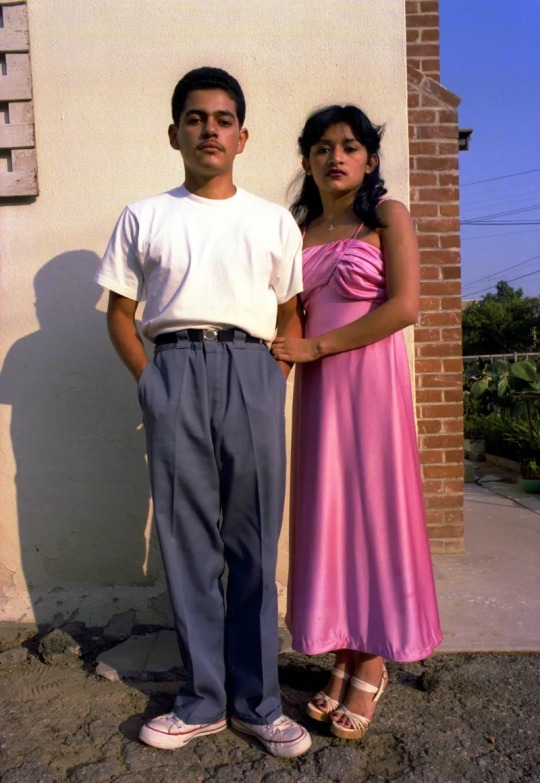
John Valadez, Couple Balam, 1978/80
#🩻#John Valadez#1970s#1980s#los angeles#chicana#chicano#east la#socal#veteranas#brown pride#photography#mexican american#xicana#west coast#history#latin american history#chicano movement#chicano art#arte latinoamericano#arte mexicano
199 notes
·
View notes
Text
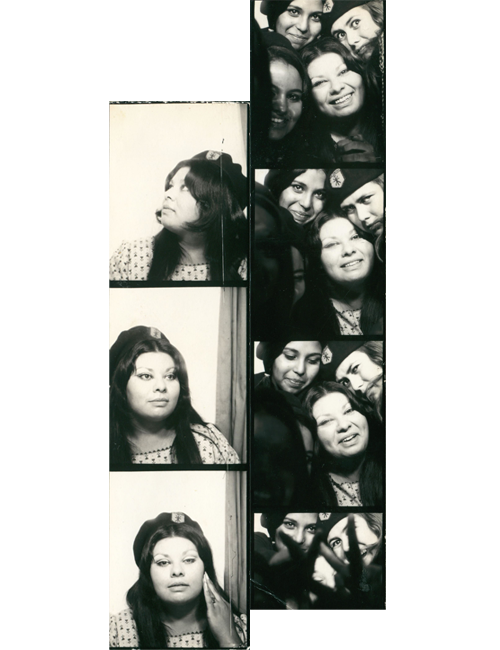
Gloria Arellanes, at left, and at center, with fellow Brown Beret members including, from clockwise: Lorraine Escalante, Hilda Reyes and Arlene Sánchez.
52 notes
·
View notes
Text
"The rights and privileges that you hold so dear today were fought for and won by those who came before you. And America fought them tooth and nail every step of the way. Those rights and privileges that you enjoy today, they weren't freely given to people like you and me [speaker is Mexican]. They were fought for by Black, Brown and Native Americans, the people of yesterday. We are where we are today not because of America, but in spite of it. In spite of America's best efforts to see to it otherwise.
Source
Just an example of this:
Chicanos/Mexican Americans fought for their right to equal education when we were given subpar education compared to white students, even when Mexican students studied at the same level or higher than their white peers. Despite many being good students they were still put in 'Mexican' classes which again were subpar and overall poor. Mexican students were geared towards vocational jobs and not encouraged to attend universities. During the school walkouts Mexican Americans and Chicanos fought for equality and for Mexican Anerican studies to be implemented. This gave our people the recognition and chance to see the importance of our culture and history in the U.S.; To empower our people that we are not defined by racist stereotypes and just because we're Mexicans does not mean we are destined to not achieve higher things and goals in life.
#🇲🇽#usa#united states#chicano history#mexican history#history#chicano movement#mexican american studies#chicano studies#mexican#hispanic#latino#latina#school walk
17 notes
·
View notes
Text
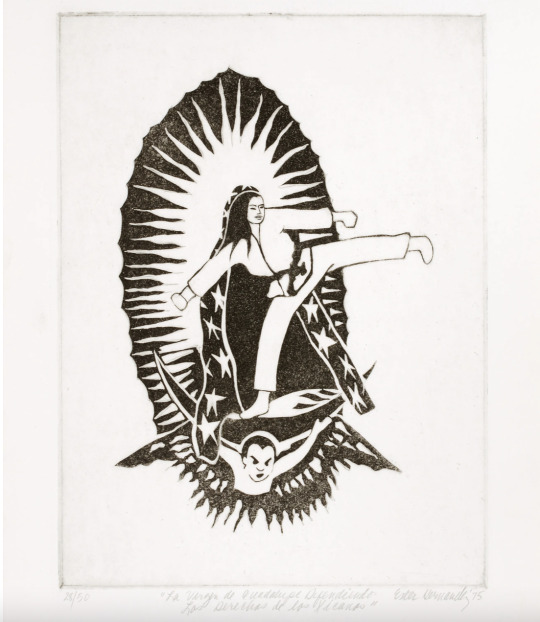
Ester Hernandez, La Virgen de Guadalupe Defendiendo los Derechos de los Xicanos, 1975, Smithsonian American Art Museum, Museum purchase through the Frank K. Ribelin Endowment, 2013.56, © 1975, Ester Hernández
https://americanart.si.edu/artwork/la-virgen-de-guadalupe-defendiendo-los-derechos-de-los-xicanos-86123
Ester Hernandez was the first prominent Chicana artist to implement the imagery of La Virgen de Guadalupe as a form of political symbolism questioning the marginalization of women in Chicano women.
3 notes
·
View notes
Text
vimeo
0 notes
Text




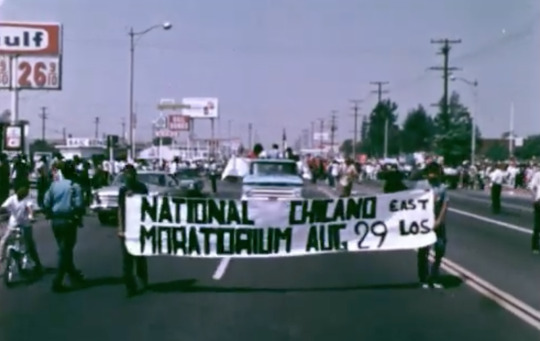






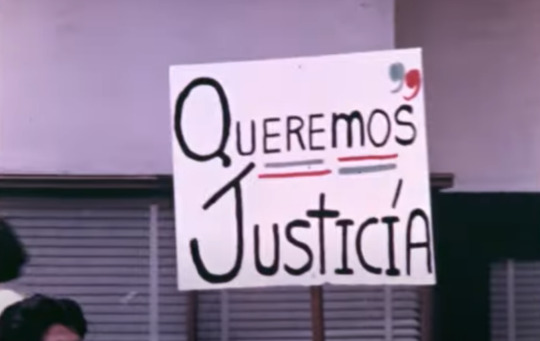
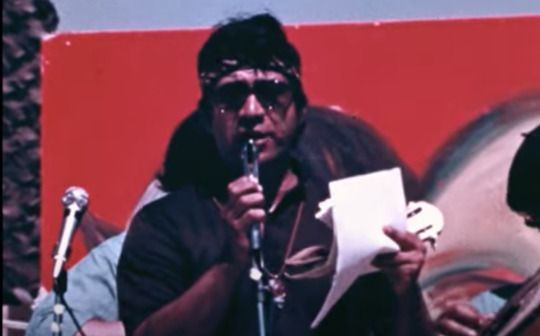



youtube
1970.
The Chicano Power Movement.
15 notes
·
View notes
Text
Idk what is is with chicano activists and aztlan. Every conversation is just "I miss aztlan you guys used to love aztlan" If you could stop appropreating mexica ancestral beliefs for your ethnostate power fantasies that would be great it makes you look goofy ash.
#I'm not gonna say the chicano movement was useless but it is genuinely so annoying that every organization from that era is still stuck#being named shit like ''the chosen children of aztlan students association''#name one native group from your area I dare you#it drags down progressive action but first of all its corny#let it go!!
3 notes
·
View notes
Text
every now and then i will have a thought about the 70s and then spontaneously combust into a thousand fla[gets dragged away by security]
#chicano was originally a slur towards mexican americans but was reclaimed during the 60s-70s during the california strikes#back then students were also mostly just taught about white history (or black if they were lucky) but never their own#so protests and calls to learn their own history was made which also resulted in heavy pride within themselves#you'll also see a lot of indigenous pride when it comes to the chicano movement back in the day#especially if you look at the murals which have a lot of inspiration derived from mexican catholicism and indigenous imagery#(which is a little ironic to me considering mexico doesn't exactly treat their indigenous population well but i digress 🫠🫠)#then we also have chicano park which is also one of the biggest icons of chicano history#it was built back in the 60s but split up a neighorhood-- the government promised to build a park to compensate but eventually the folks li#-ing there found out they were going to turn it into a patrol station instead and protested in 1970#eventually chicano park was built and after it opened a shit ton of murals came up because at the time there was the chicano mural movement#and a muralist proposed letting others paint on the walls since a lot of the structures built happened to be pretty good canvases#this is all kinda basic history and you could easily look most of this up lmao#i just like rambling#anyways thats my time folks security is eyeing me like they're about to ban me okay b[Electric Taser SFX]#pyro screams to the abyss
3 notes
·
View notes
Text
When Special Interests Collide: 9-1-1 & Linguistics Edition
Peruvian and Mexican Spanish are unique dialects - heavily influenced by local indigenous languages - where several words don't even sound similar to each other. An "accent" isn't going to be what trips Eddie and Buck up when talking to each other, it's going to be slang and regional differences.
Think soda vs pop vs sodapop vs soft drink vs coke or coca-cola vs lemonade vs Sprite vs other brand names for lemon-lime soda. All equally correct ways to refer to the same thing, varying only by dialectical context and specificity. (In some parts of the South, all soda is coke or coca-cola. In some parts of the world as a whole, all lemon-lime soda is called lemonade while lemonade itself is lemon juice. In my part of the world, all lemon-lime soda is Sprite.)
Some dialects are more common - almost everyone in North America who learns Spanish in school learns Northeastern Mexican Spanish with Texan influence and almost everyone in Europe who learns Spanish the same way learns Castilian Spanish.
(Eddie may have learned any of the 10 dialects of Spanish local to Mexico from his family or even a Texican variant from before the border changed. He may also be fluent in Spanglish, which is a structured code-switching system between Spanish and English, with some creole words thrown in where appropriate to its own internal rules.)
Andean-Coastal Spanish is the most common form spoken in Peru out of five recognized dialects, and it's extremely common in Ecuador as well but almost unheard of in the United States and Canada.
It's not just "saying words funny" or "sounding like the white boy he is". It's far more like a Scots English speaker talking to a Bostonian. Which I'm aware sounds exactly like "saying words funny" to the uneducated, but that's why I'm making this post. <3
An accent is how the oral posture (the way the parts of your mouth move) of your native language affects how you say words in a learned language. It can also be how the posture of your native signed language affects how you form signs in others, or how the alphabet of your native language affects how you write characters and symbols in another alphabet.
You can have a strong accent, but not a bad accent.
A dialect is a variation of a language, with its own grammar, syntax, and vocabulary similar but distinct from other dialects of the same language. Or, in rare cases, grammar or vocabulary completely different from other dialects! Most dialects of the same language are mutually intelligible, meaning you can understand what the person means even if not what they say.
You can speak a different dialect or mimic a dialect badly, but you cannot speak a wrong dialect.
A language is a system of communication with distinct, nuanced rules governing how - and sometimes in which situations - it is used. Most languages are mutually unintelligible, meaning the speaker of one cannot understand the other at all. If two languages are from the same language family, they may be partially intelligible instead, meaning you can get the gist or pick up keywords, but you cannot understand completely.
In addition to speaking a different language, you can speak a wrong language or speak a language badly, depending on the context.
TL;DR: Peruvian and Mexican Spanish are dialects of the same language, with similar but different rules and vocabulary, which Buck would speak with an American accent. As a bilingual person, if Eddie learned Peruvian Spanish, he would likely speak it with an American accent on some words and a Mexican Spanish accent on others. If Buck was speaking Peruvian Spanish correctly and Eddie was speaking Mexican Spanish, they would mostly understand each other, but not completely, and their accents would not affect that.
#/incoherent noises/#911 tv show#911 eddie#911 buck#911 buddie#languages and linguistics#spanish dialects#dialect differences#tune in next time when i talk about the effects of the chicano movement on a mexican army man whose father lived through it#or not i mean it really depends on my goddamn energy#long post#tldr included
13 notes
·
View notes
Text
I always know a book about mexican/mexican-american women by a mexican/mexican-american woman is going to be good when the reviews from xicana women are glowing and the reviews from white us women are like, ":/ I couldn't relate to this character, why did they do [cultural thing] when they could have just not?"
#like ahahahaha this wasn't for you!! sorry you can't relate to anyone who isn't white sounds like a skill issue!!#anyway malas by maricela fuentes is chewing on my heart rn as a tejana xicana growing up in a post-chicano movement texas#i have Thoughts on the chicano movement. thanks for the labor rights but I will fight chavez atop a mound of bones in hell#for the gender shit you see#don't trust a nationalist movement based on creepy nostalgia for a long bygone era
0 notes
Text
youtube
0 notes
Text
Ritchie Valens - La Bamba 1958
"La Bamba" is a Mexican folk song, originally from the state of Veracruz, also known as "La Bomba". The song is best known from a 1958 adaptation by rock and roll pioneer and forefather of the Chicano rock movement Ritchie Valens, which became a Top 40 hit on the US charts. Valens's version is ranked number 345 on Rolling Stone magazine's list of the 500 Greatest Songs of All Time. "La Bamba" has been covered by numerous artists, notably by Los Lobos whose version was the title track of the 1987 film La Bamba, a bio-pic about Valens; their version reached number 1 on many charts in the same year. Their music video won the 1988 MTV Video Music Award for Best Video from a Film.
"La Bamba" is a classic example of the son jarocho musical style, which originated in the Mexican state of Veracruz, and combines Spanish, indigenous, and African musical elements. "La Bamba" likely originated in the last years of the 17th century. The oldest known historical references come from the town of Alvarado, Mexico, where it apparently was performed with an atypically lively rhythm. The oldest recorded version known is that of Alvaro Hernández Ortiz, who recorded the song with the name of "El Jarocho". His recording was released by Victor Records in Mexico in 1938 or 1939, and was reissued on a 1997 compilation by Yazoo Records, The Secret Museum of Mankind Vol. 4.
Ritchie Valens learned the song in his youth. In 1958 he recorded a rock and roll flavored version of "La Bamba", originally released as the B-side of his number-two hit "Donna". His recording of the song was inducted into the Latin Grammy Hall of Fame and the Grammy Hall of Fame. On February 3, 1959, on what has become known as "The Day the Music Died", Valens died in a plane crash in Iowa, an accident that also claimed the lives of fellow musicians Buddy Holly and J.P. "The Big Bopper" Richardson, as well as their pilot. Valens was 17 years old at the time of his death. He was posthumously inducted into the Rock and Roll Hall of Fame, the Rockabilly Hall of Fame, the Native American Music Awards Hall of Fame, the California Hall of Fame, and has a star on the Hollywood Walk of Fame. In 2018, his version of "La Bamba" was selected by the Library of Congress for preservation in the National Recording Registry for being "culturally, historically, or aesthetically significant".
"La Bamba" received a total of 92,2% yes votes!
youtube
892 notes
·
View notes
Text
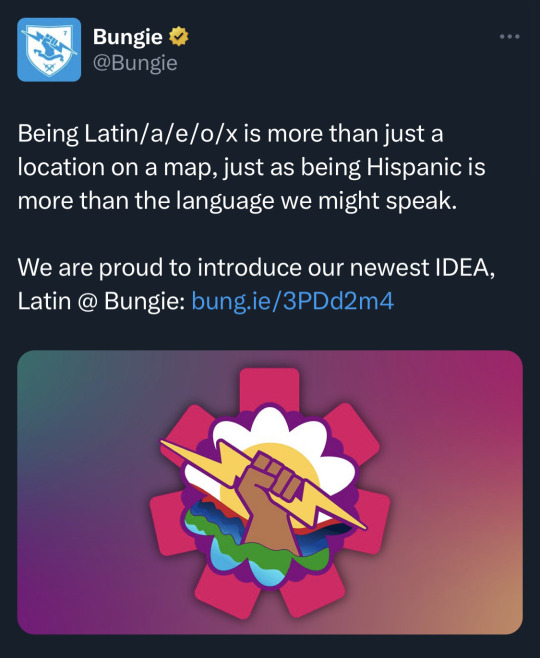
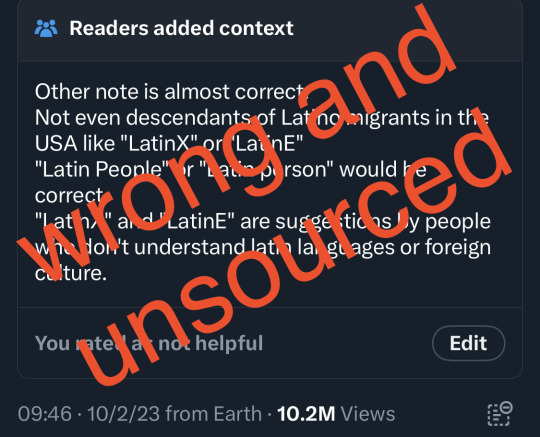
So bungie made this post, and it’s getting dog piled by reactionary morons. Latinx derives from Chicano movements incorporating a Nahua ‘X’ into modern Spanish (Chicano can be rendered as Xicano with almost the same pronunciation). Chicanx was a way to incorporate a linguistic heritage that was almost wiped out by the Spaniards, challenge Spaniard led linguistic rigidity in gendered language, and also speak to the American relationship with the letter ‘x’ (Malcom X, the usage of X to mark slave cargo etc).
It’s a regional thing, invented by those that that thought it worked for them. If it doesn’t apply to a Hispanic or Latino because they don’t have a Nahua ancestral root, cool! It wasn’t supposed to be all encompassing. And yet the response is just pure smoothbrain reactionary - especially for something which is just a regional thing. What? Chifa isn’t a word because it’s only in Peru?
If you use Twitter, go mark that stupid community note as unsourced and incorrect.
https://x.com/bungie/status/1708886230492967428?s=46&t=gD2LFCz8QzvT16bpU8LsQA
533 notes
·
View notes
Text
JSTOR Daily offers a profound exploration of Chicanx, a term historically associated with Mexican Americans, through a meticulously curated reading list. This collection begins by analyzing the construction of race for Mexican descendants in the U.S., highlighting how institutional racial constructs led to discrimination and overshadowed the diverse Indigenous, Black, and European ancestries. The list includes pivotal works from the Chicano Movement of the 1960s and 1970s, focusing on activism against historical injustices in education, policing, and housing.
Central to this collection is Chicana Feminism, which expanded the conversation to include intersectional views on race, gender, and sexuality. This shift mirrors the evolution of Chicanx identity, from a cultural marker to a political identity encompassing various racial and ethnic backgrounds.
Concluding with the latest interdisciplinary studies in Chicanx, the list showcases recent research on LGBTQ+ experiences and issues shared by Mexican and Central American communities. This evolution in the field is exemplified by changes in academic departments, like the renaming of the UCLA César E. Chávez Department to include Central American Studies. JSTOR Daily invites readers to a scholarly journey through the dynamic history and identity of the Chicanx community with this comprehensive reading list.
#jstor#jstor daily#reading list#chicanx studies#central american studies#mexican studies#chicana feminism
152 notes
·
View notes
Text

Judy Baca, Absolutely Chicana, 2008. Screenprint. Collection of the McNay Art Museum, Gift of Harriett and Ricardo Romo, 2013.25.
https://www.mcnayart.org/exhibition/estampas-chicanas/
Judy Baca's work included in the Estampas Chicanas exhibit in the McNay Art Museum continues to acknowledge and reflect Chicana's struggle to be included and respected in the Chicano Labor movement.
0 notes
Text
introductory excerpts on COINTELPRO
it came to my awareness that some folks don't know what COINTELPRO is still, so imma drop some excerpts from the wikipedia page. ofc there are a billion other resources you can check out, especially firsthand accounts, but this is always a good place to start! link attached below:
[Note that the embedded link above's photo has the following caption: "COINTELPRO memo proposing a plan to expose the pregnancy of actress Jean Seberg, a financial supporter of the Black Panther Party, hoping to "possibly cause her embarrassment or tarnish her image with the general public". Covert campaigns to publicly discredit activists and destroy their interpersonal relationships were a common tactic used by COINTELPRO agents."]
The Introduction:
COINTELPRO (syllabic abbreviation derived from Counter Intelligence Program; 1956–1971) was a series of covert and illegal[1][2] projects actively conducted by the United States Federal Bureau of Investigation (FBI) aimed at surveilling, infiltrating, discrediting, and disrupting domestic American political organizations.[3][4] FBI records show COINTELPRO resources targeted groups and individuals the FBI[5] deemed subversive,[6] including feminist organizations,[7][8] the Communist Party USA,[9] anti–Vietnam War organizers, activists of the civil rights and Black power movements (e.g. Martin Luther King Jr., the Nation of Islam, and the Black Panther Party), environmentalist and animal rights organizations, the American Indian Movement (AIM), Chicano and Mexican-American groups like the Brown Berets and the United Farm Workers, independence movements (including Puerto Rican independence groups such as the Young Lords and the Puerto Rican Socialist Party), a variety of organizations that were part of the broader New Left, and white supremacist groups such as the Ku Klux Klan[10][11] and the far-right group National States' Rights Party.[12]
Methods COINTELPRO Utilized
According to attorney Brian Glick in his book War at Home, the FBI used five main methods during COINTELPRO:
Infiltration: Agents and informers did not merely spy on political activists. Their main purpose was to discredit, disrupt and negatively redirect action. Their very presence served to undermine trust and scare off potential supporters. The FBI and police exploited this fear to smear genuine activists as agents.
Psychological warfare: The FBI and police used a myriad of "dirty tricks" to undermine movements. They planted false media stories and published bogus leaflets and other publications in the name of targeted groups. They forged correspondence, sent anonymous letters, and made anonymous telephone calls. They spread misinformation about meetings and events, set up pseudo movement groups run by government agents, and manipulated or strong-armed parents, employers, landlords, school officials, and others to cause trouble for activists. They used bad-jacketing to create suspicion about targeted activists, sometimes with lethal consequences.[74]
Harassment via the legal system: The FBI and police abused the legal system to harass dissidents and make them appear to be criminals. Officers of the law gave perjured testimony and presented fabricated evidence as a pretext for false arrests and wrongful imprisonment. They discriminatorily enforced tax laws and other government regulations and used conspicuous surveillance, "investigative" interviews, and grand jury subpoenas in an effort to intimidate activists and silence their supporters.[73][75]
Illegal force: The FBI conspired with local police departments to threaten dissidents; to conduct illegal break-ins in order to search dissident homes; and to commit vandalism, assaults, beatings and assassinations.[73] The objective was to frighten or eliminate dissidents and disrupt their movements.
Undermine public opinion: One of the primary ways the FBI targeted organizations was by challenging their reputations in the community and denying them a platform to gain legitimacy. Hoover specifically designed programs to block leaders from "spreading their philosophy publicly or through the communications media". Furthermore, the organization created and controlled negative media meant to undermine black power organizations. For instance, they oversaw the creation of "documentaries" skillfully edited to paint the Black Panther Party as aggressive, and false newspapers that spread misinformation about party members. The ability of the FBI to create distrust within and between revolutionary organizations tainted their public image and weakened chances at unity and public support.[49]
The FBI specifically developed tactics intended to heighten tension and hostility between various factions in the black power movement, for example between the Black Panthers and the US Organization. For instance, the FBI sent a fake letter to the US Organization exposing a supposed Black Panther plot to murder the head of the US Organization, Ron Karenga. They then intensified this by spreading falsely attributed cartoons in the black communities pitting the Black Panther Party against the US Organization.[49] This resulted in numerous deaths, among which were San Diego Black Panther Party members John Huggins, Bunchy Carter and Sylvester Bell.[73] Another example of the FBI's anonymous letter writing campaign is how they turned the Blackstone Rangers head, Jeff Fort, against former ally Fred Hampton, by stating that Hampton had a hit on Fort.[49] They also were instrumental in developing the rift between Black Panther Party leaders Eldridge Cleaver and Huey Newton, as executed through false letters inciting the two leaders of the Black Panther Party.[49]
...
In order to eliminate black militant leaders whom they considered dangerous, the FBI is believed to have worked with local police departments to target specific individuals,[78] accuse them of crimes they did not commit, suppress exculpatory evidence and falsely incarcerate them. Elmer "Geronimo" Pratt, a Black Panther Party leader, was incarcerated for 27 years before a California Superior Court vacated his murder conviction, ultimately freeing him. Appearing before the court, an FBI agent testified that he believed Pratt had been framed, because both the FBI and the Los Angeles Police Department knew he had not been in the area at the time the murder occurred.[79][80]
...
In 1969 the FBI special agent in San Francisco wrote Hoover that his investigation of the Black Panther Party had concluded that in his city, at least, the Panthers were primarily engaged in feeding breakfast to children. Hoover fired back a memo implying the agent's career goals would be directly affected by his supplying evidence to support Hoover's view that the Black Panther Party was "a violence-prone organization seeking to overthrow the Government by revolutionary means".[84]
Hoover supported using false claims to attack his political enemies. In one memo he wrote: "Purpose of counterintelligence action is to disrupt the Black Panther Party and it is immaterial whether facts exist to substantiate the charge."[85]
Intended Effects of COINTELPRO
The intended effect of the FBI's COINTELPRO was to "expose, disrupt, misdirect, or otherwise neutralize" groups that the FBI officials believed were "subversive"[58] by instructing FBI field operatives to:[59] 1. Create a negative public image for target groups (for example through surveilling activists and then releasing negative personal information to the public) 2. Break down internal organization by creating conflicts (for example, by having agents exacerbate racial tensions, or send anonymous letters to try to create conflicts) 3. Create dissension between groups (for example, by spreading rumors that other groups were stealing money) 4. Restrict access to public resources (for example, by pressuring non-profit organizations to cut off funding or material support) 5. Restrict the ability to organize protest (for example, through agents promoting violence against police during planning and at protests) 6. Restrict the ability of individuals to participate in group activities (for example, by character assassinations, false arrests, surveillance)
When did they start?
Centralized operations under COINTELPRO officially began in August 1956 with a program designed to "increase factionalism, cause disruption and win defections" inside the Communist Party USA (CPUSA). Tactics included anonymous phone calls, Internal Revenue Service (IRS) audits, and the creation of documents that would divide the American communist organization internally.[9] An October 1956 memo from Hoover reclassified the FBI's ongoing surveillance of black leaders, including it within COINTELPRO, with the justification that the movement was infiltrated by communists.[31] In 1956, Hoover sent an open letter denouncing Dr. T. R. M. Howard, a civil rights leader, surgeon, and wealthy entrepreneur in Mississippi who had criticized FBI inaction in solving recent murders of George W. Lee, Emmett Till, and other African Americans in the South.[32] When the Southern Christian Leadership Conference (SCLC), an African-American civil rights organization, was founded in 1957, the FBI began to monitor and target the group almost immediately, focusing particularly on Bayard Rustin, Stanley Levison, and eventually Martin Luther King Jr.[33]
How did the news get out about COINTELPRO?
The program was secret until March 8, 1971, when the Citizens' Commission to Investigate the FBI burgled an FBI field office in Media, Pennsylvania, took several dossiers, and exposed the program by passing this material to news agencies.[1][54] The boxing match known as the Fight of the Century between Muhammad Ali and Joe Frazier in March 1971 provided cover for the activist group to successfully pull off the burglary. Muhammad Ali was a COINTELPRO target because he had joined the Nation of Islam and the anti-war movement.[55] Many news organizations initially refused to immediately publish the information, with the notable exception of The Washington Post. After affirming the reliability of the documents, it published them on the front page (in defiance of the Attorney General's request), prompting other organizations to follow suit. Within the year, Director J. Edgar Hoover declared that the centralized COINTELPRO was over, and that all future counterintelligence operations would be handled case by case.[56][57]
#reaux speaks#black panther party#fbi corruption#cointelpro#counterinsurgency#revolution#martin luther king jr#black power#intersectional feminism#indigenous#young lords#history#wikipedia#communism#socialism#j edgar hoover#mccarthyism
377 notes
·
View notes